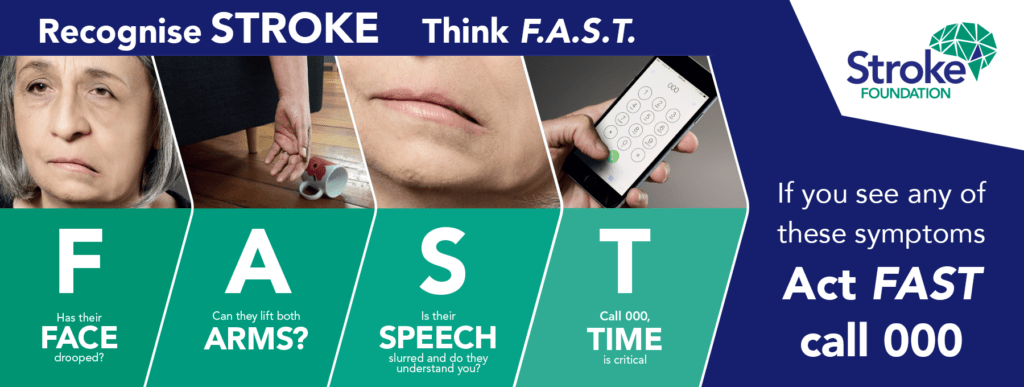Emergency First Aid are proud to support the Stroke Foundation in raising awareness for National Stroke Week.
Globally, one in four people will have a stroke in their lifetime. In Australia this means that nearly 500,000 people are living with the effects of stroke. The good news is that more than 80% of strokes can be prevented.
So what can we do to help someone that maybe having a stroke?
Think… F.A.S.T.
The Stroke Foundation recommends the F.A.S.T. test as an easy way to remember the most common signs of stroke. Using the F.A.S.T. test involves asking these simple questions: F – Face Check their face. Has their mouth drooped?
A – Arms Can they lift both arms?
S– Speech Is their speech slurred? Do they understand you?
T – Time Is critical. If you see any of these signs call 000 straight away.



Other signs of stroke
Facial weakness, arm weakness and difficulty with speech are the most common symptoms or signs of stroke, but they are not the only signs.
The following signs of stroke may occur alone or in combination:
- Weakness or numbness or paralysis of the face, arm or leg on either or both sides of the body
- Difficulty speaking or understanding
- Dizziness, loss of balance or an unexplained fall
- Loss of vision, sudden blurring or decreased vision in one or both eyes
- Headache, usually severe and abrupt onset or unexplained change in the pattern of headaches
- Difficulty swallowing
Sometimes the signs disappear within a short time, such as a few minutes. When this happens, it may be a transient ischaemic attack (TIA). After a TIA, your risk of stroke is higher. Stroke can lead to death or disability. A TIA is a warning that you may have a stroke and an opportunity to prevent this from happening.
While you are waiting for the ambulance to arrive:
- If the person is conscious, lay them down on their side with their head slightly raised and supported.
- Do not give them anything to eat or drink.
- Loosen any restrictive clothing that could cause breathing difficulties.
- If weakness is obvious in any limb, support it and avoid pulling on it when moving the person.
- If they are unconscious, check their breathing and pulse and put them on their side. If they do not have a pulse or are not breathing, start CPR straight away.
- If you are unsure how to perform CPR, the ambulance call taker will give instructions over the phone.
If you would like to book a first aid course to learn more about responding to stroke, delivering CPR, saving a life and other first aid emergencies click here

